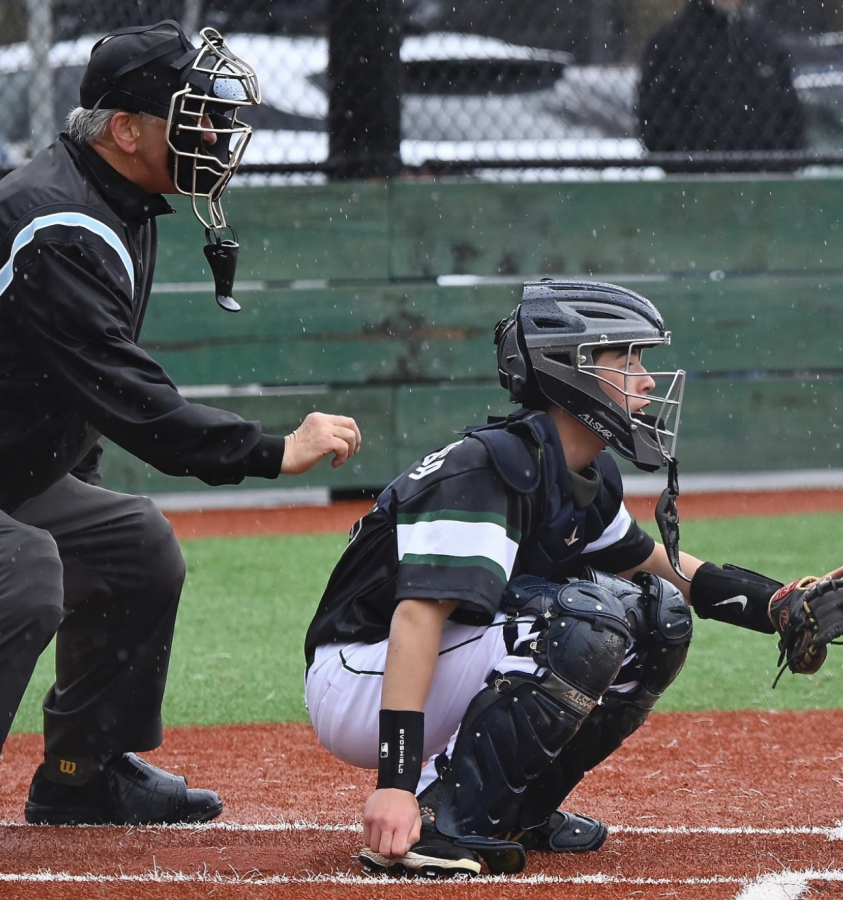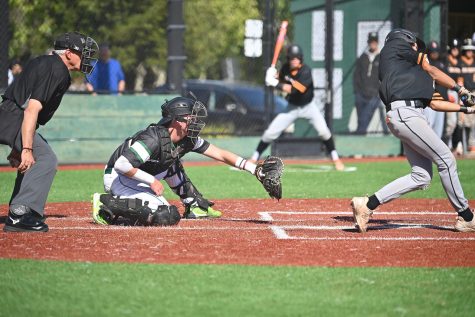That’s the ball game! The Astros defeated the Phillies 5-2 in game two of the 2022 World Series. This game was a staple in history, but not for the reason you would think. Umpire Pat Hoberg called a perfect game, calling 89 balls and 40 strikes perfectly.
In every sport, referees are a core element of the game. They interpret the rules to make the game as fair as possible for both teams. While refs are important in other sports, umpires are crucial for the game of baseball. Every single moment of action in a baseball game involves an umpire, every pitch, hit, tag, swing and throw. Baseball umpires don’t monitor a game, they control it. In a typical MLB game, an umpire can make three to four hundred calls.
Every professional MLB game has four umpires, one for each plate. The home plate umpire is the most important, calling all balls, strikes and plays at home plate. The first, second, and third plate umpires watch if the batter swings, in addition to making all calls at their respective bases.
Every pitch has five possible outcomes: ball, called strike, swinging strike, foul ball and a hit. The most important of these are the balls and called strikes. The strike zone is an imaginary box that spans over the home plate, under the batter’s mid torso, and above the batter’s knee. If the batter does not swing, it is up to the home plate umpire to determine if the ball crossed home plate inside or outside the box. If it is inside the box, it is called a strike, and if it is outside the box, it is called a ball.
MLB umpires, being human, are not perfect 100% of the time. With balls traveling at over 90 miles per hour, it is very difficult for umpires to pinpoint the exact location of every single pitch. With the development of ball tracking technology, many fans argue that human umpires should be replaced by their robotic counterparts. The automated ball and strike system (ABS), better known as automated umpires, creates a three dimensional graph of the baseball using multiple camera angles. This computer precision can track a fast moving baseball better than any human umpire.
Despite this automated system’s accuracy, fully transitioning to ABS is not the best option for the future of the MLB.
There are many reasons that support this, one of them being the removal of framing. Framing is a method used by catchers in which they catch the ball at an angle that makes a ball look like a strike to a human umpire. Framing is the skill that separates good and great catchers. Statistically, catchers who are good at framing record around 10% more strikes than catchers who aren’t good at framing. Some of the best framers in the MLB are Patrick Bailey of the San Francisco Giants and Austin Wells of the New York Yankees. Adding automated umpires will dramatically reduce the effectiveness of framing, which will subsequently reduce the value of a good catcher.
A big part of baseball is the catcher and umpire relationship. Throughout the game, umpires and catchers often have polite conversations with a goal of getting fair calls. For instance, a catcher can respectfully protest an umpire’s call by talking to him. If the umpire agrees, he will concede that call the next time a similar pitch occurs.
People often believe that it is really easy to become an umpire. However, becoming a MLB umpire is far from easy. To apply, a trainee must join a one day bootcamp; if he performs well, he will be sent to a one month training camp along with 150 other umpires. Top performers must go through five different levels of the minor leagues before reaching the majors. Rookie ball, Low-A, High-A, Double A, and Triple A. If an umpire does not display excellent accuracy, they will never be promoted. Generally, only one in 150 umpires will get to the majors, that is 0.67%. On average, it takes 10 years of umpiring in the minors to reach the majors. During these 10 years, a minor league umpire only gets paid around 25 thousand dollars a year. This system ensures that the MLB umpires are the best of the best.
There is a common misconception that MLB umpires are ensured job security by the umpiring union. This is not completely true. After every game, each umpire will receive a score projecting their accuracy for that game. If an umpire’s accuracy gets too low over many games, they will be put on a probation period. During this probation period, an umpire must improve their accuracy or they will be demoted or fired. Infamous umpires like Angel Hernandez and Joe West stayed above this threshold which protected them from getting fired. Umpires can also get suspended, however these suspensions are not released to the public. Statistically, this system has proven to work. Over the past 17 MLB seasons, umpire accuracy has gone up every year.
Adding on to this, having a fully accurate umpire will not solve all disputes over called balls and strike. Coaches and players will still get mad even if every call is perfect. For example, in a game between the Red Sox and Astros, Red Sox manager Alex Cora got into a screaming match with the umpire even though the umpire, according to the automated system, didn’t make a single incorrect call. Even if an umpire does a perfect job, one of the teams will still be mad. As an official it is impossible to please both teams, as one of the teams will inevitably lose.
Additionally, umpire confrontations are a core aspect of baseball. In my opinion, some of the most entertaining moments in major league baseball is when players and managers get into arguments with umpires. Umpire arguments have a unique tone that is both funny and serious at the same time. A majority of arguments often end with a player or manager getting ejected. Having these arguments adds an extra layer of entertainment to baseball which many other sports don’t have. There are full youtube channels dedicated to breaking down these arguments and reading the participant’s lips.
Automated umpires can also disagree on strike zone. A certain team’s broadcast can be biased towards their own team. For example, during a game between the Cardinals and Mets, one pitch was called a ball by the Cardinals broadcast, a strike was called on the Mets broadcast, a strike on MLB.com, and a ball by the umpire. This pitch occurred at the top of the strike zone which is the most disputed area of the strike zone. According to the rule book, it is a line drawn at 51% of the batter’s height, which is a very approximate location.
Many umpires’ estimated zones don’t perfectly correlate with the MLB’s standard zone, but they stay consistent for both teams throughout the game. As long as both teams are treated equally it doesn’t matter if an umpire’s zone is slightly off the standard zone. Adding on to this, many players often adjust their strategy based on an umpire’s estimated zone. For example, if an umpire is calling a lot of outside pitches strikes, the batter will have to start swinging at outside pitches. With automated umpires, this layer of the game will be completely removed.
Occasionally, it can appear to fans on TV that an umpire repeatedly makes incorrect calls. However, the box shown on TV can often be misleading to fans, for it is usually not accurate. The broadcasted zone often doesn’t take into account factors like the camera angle and the batter’s stance.
Building on this, renowned players like Shohei Ohtani and Aaron Judge aren’t famous for their good batting discipline, they are famous for being able to hit a lot of homeruns. Fans don’t watch games to see 200 perfectly called pitches, they watch to witness big hits and exciting moments.
Finally, technology just isn’t as reliable as humans. Even with current advancements, computers can still frequently break down and have bugs. These glitches can slow down the pace of the game and make it feel boring.
Instead of having fully automated umpires, the MLB should implement a balls and strikes challenge system. As of right now, it is illegal for a player or manager to argue a ball or strike call. Managers should be given the option to challenge a call if they feel like it is incorrect. During a challenge, a human umpire can check with the automated umpire to see if he made the correct call. This system has already been implemented in certain minor leagues and has been proven to be successful. The process will consist of a batter or catcher to calling for a challenge right after a pitch. The ABS should immediately make a call within seconds. Teams should be allowed around three unsuccessful challenges per game. Obviously a team should not be penalized for having a successful challenge. The combination of the limited challenges and fast computer should allow the game to flow as normal with minimal interruptions. This keeps the human aspect of umpiring in the game while ensuring the correct calls will be made in the biggest moments.
At the end of the day, baseball is a human game and it should be controlled by humans. Umpires make mistakes just like players make mistakes. Human umpires are just another part of the amazing game of baseball.
Check out how some umpires are performing in the MLB: Umpire Scorecards





